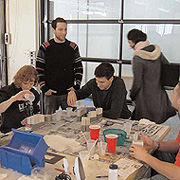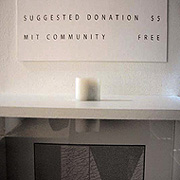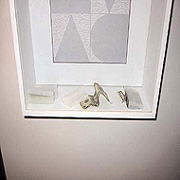|
A few notes must be listed as to the physical production or success of the objects and the receptacle. The objects themselves seemed quite successful. People responded positively to the shape, size, texture, consistency and appearance of the objects. Their translucent appearance presumably lent itself to the intuition of a concealed purpose or agenda for their distribution. The success of the objects' appeal can be measured by the fact that of 100 distributed, only 30 were returned. Of these 30 only about half contained money. Of the 15 or so with money only one contained a 5 dollar bill. None contained a 10. In speaking with the attendants, one observation attributed to the small monetary return was that visitors seemed unaware of the return box and the profile of the object cut into its top. For some visitors, it seems, the object seemed plainly a gift, nothing else. Of those who did notice the box, it was reported that it only caught their eye due to the fact that people could see other "Cacht" objects already inside it, through the box's clear front panel. Of those who returned the object without the money it can only be assumed that their time and needs seemed to be more valuable than those of the gallery. That, or they did not make the connection between the money and the act of donation and assumed the money was simply a gift in the name of an experiment. Perhaps they imagined that they were meant to reflect on the activity of being given money and carrying it around inside a gallery space. All in all, I would recommend repeating "Cacht" in other environments and under different circumstances. Its value as a social experiment seems interesting. However, of most interest is the factor of its arousal of participant's suspicion. This would be interesting to test in different communities and cultures. It would also be interesting to examine how this sense of suspicion might be heightened or dampened: played with and modulated as an artist might do with a series of lines on a page. This emotion, this arousal, seems to be the most poignant, unique and charged canvas of the piece. It is also the response that provides the piece with the greatest range of ambiguity or ambivalence. It is in this area, this gray zone between generosity and manipulation, that the characteristics and sensibilities, the hues and values, of cultures and communities can most effectively be drawn out and framed; organized into a piece of open communication. This is then a piece with neither a positive nor negative message, but a message drawn instead from the minute dilemmas and decisions of the human consciousness. |
   |